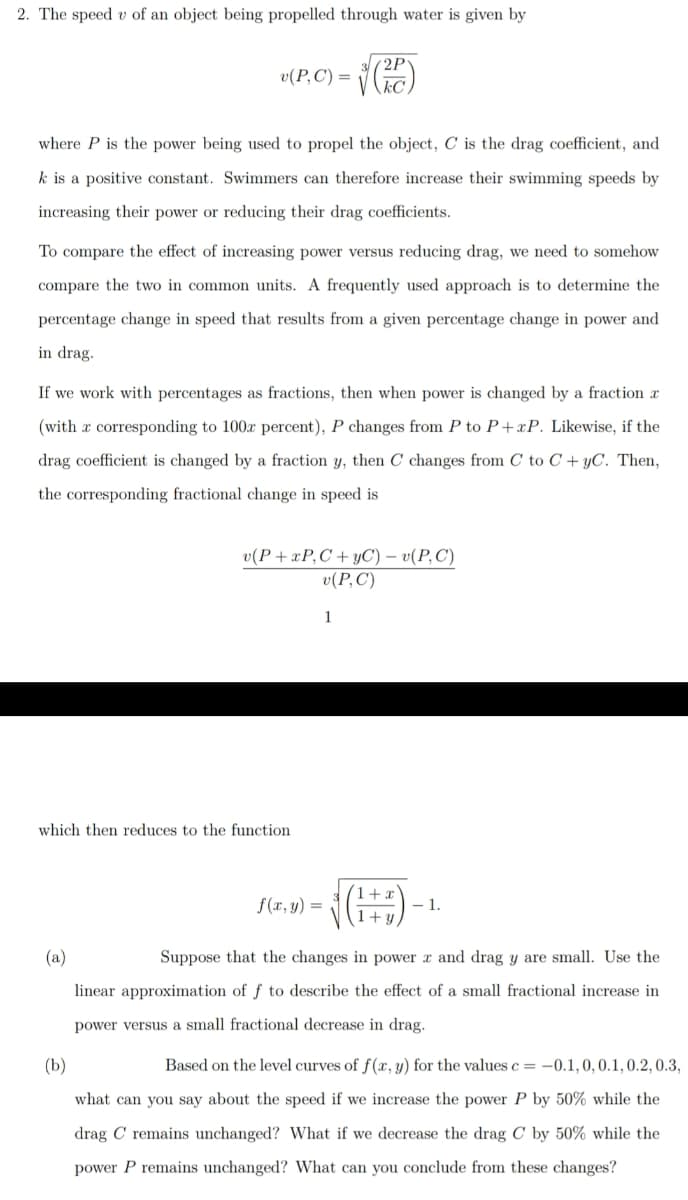1. (a) Suppose that the changes in power a and drag y are small. Use the linear approximation of f to describe the effect of a small fractional increase in power versus a small fractional decrease in drag.
1. (a) Suppose that the changes in power a and drag y are small. Use the linear approximation of f to describe the effect of a small fractional increase in power versus a small fractional decrease in drag.
Algebra & Trigonometry with Analytic Geometry
13th Edition
ISBN:9781133382119
Author:Swokowski
Publisher:Swokowski
Chapter4: Polynomial And Rational Functions
Section: Chapter Questions
Problem 5T
Related questions
Question
100%
Q2

Transcribed Image Text:2. The speed v of an object being propelled through water is given by
2P
v(P,C') =
where P is the power being used to propel the object, C is the drag coefficient, and
k is a positive constant. Swimmers can therefore increase their swimming speeds by
increasing their power or reducing their drag coefficients.
To compare the effect of increasing power versus reducing drag, we need to somehow
compare the two in common units. A frequently used approach is to determine the
percentage change in speed that results from a given percentage change in power and
in drag.
If we work with percentages as fractions, then when power is changed by a fraction x
(with a corresponding to 100x percent), P changes from P to P + xP. Likewise, if the
drag coefficient is changed by a fraction y, then C changes from C to C + yC. Then,
the corresponding fractional change in speed is
u(Р+хP,С +УС) - о(Р, С)
v(P,C)
1
which then reduces to the function
(1+:
f(x, y) =
- 1.
(a)
Suppose that the changes in power x and drag y are small. Use the
linear approximation of f to describe the effect of a small fractional increase in
power versus a small fractional decrease in drag.
(Ь)
Based on the level curves of f(x,y) for the values c = –0.1, 0, 0.1,0.2, 0.3,
what can you say about the speed if we increase the power P by 50% while the
drag C remains unchanged? What if we decrease the drag C by 50% while the
power P remains unchanged? What can you conclude from these changes?
Expert Solution
This question has been solved!
Explore an expertly crafted, step-by-step solution for a thorough understanding of key concepts.
This is a popular solution!
Trending now
This is a popular solution!
Step by step
Solved in 2 steps with 2 images

Recommended textbooks for you

Algebra & Trigonometry with Analytic Geometry
Algebra
ISBN:
9781133382119
Author:
Swokowski
Publisher:
Cengage

Algebra & Trigonometry with Analytic Geometry
Algebra
ISBN:
9781133382119
Author:
Swokowski
Publisher:
Cengage